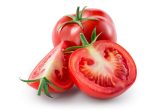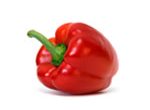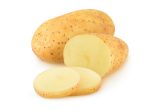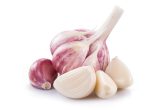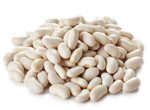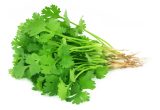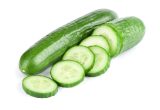Broad beans

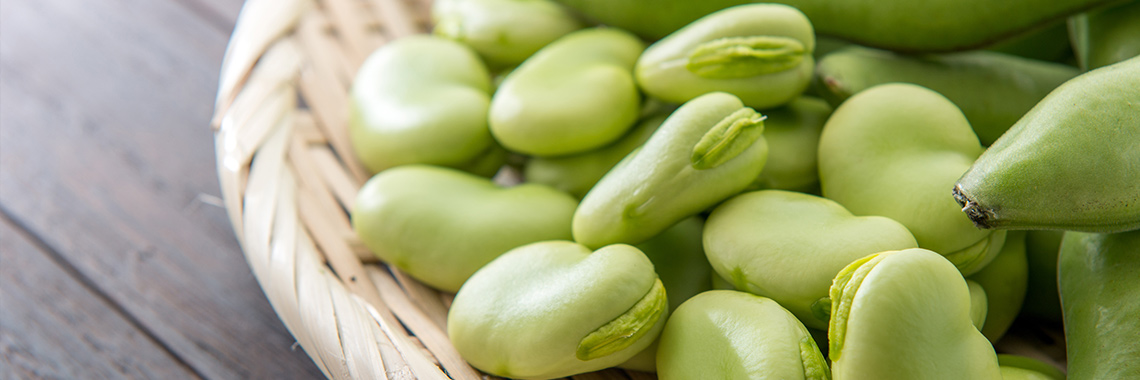
Description
- Broad beans (Vicia faba) belong to the Fabaceae family.
- There are different cultivars of broad bean, including Windsor White, Bachus and Basta (Pysz, 2012).
PHYSICAL AND ORGANOLEPTIC CHARACTERISTICS
- The volatile profile of a Canadian broad bean variety (Vivia faba var. Minor) was studied. Despite their low lipid content, significant amounts of volatile substances normally associated with unsaturated fatty acids were present (Akkad, 2019).
- It has been shown that the volatile compounds of broad beans are aromatic hydrocarbons, aldehydes, alkanes, alkenes, alcohols, ketones, furans and other compounds (Roland, 2017).
- The unpleasant flavours reported for broad bean protein isolates may depend on pH. At neutral pH, a dried pea flavour was reported, while at acidic pH, an unpleasant fruity flavour was reported (Roland, 2017).
- Ordinary broad beans contain up to 8-9% tannins, a subgroup of polyphenols which may explain their perceived bitterness (Roland, 2017). The presence of saponin is also thought to be responsible for the bitter taste of broad beans (Marais, 2016).
COMPOSITION CHARACTERISTICS (excluding macronutrients, vitamins and minerals)
- 155 primary and secondary metabolites were found to be present in the broad bean seed, mainly polyphenols, organic acids, alkaloids, terpenoids and jasmonates (Abu-Reidah, 2014). Specifically, 134 phenolic and other phytochemical compounds were found in the extract of Vicia faba, most of which have not been described so far in broad beans (Abu-Reidah, 2017).
- Among the phenolic compounds are functional flavonoids such as tannin, proanthocyanidins (especially prodelphinidin and catechin), L-3,4-dihydrophenylalanine (L-dopa), flavonols and flavones (especially myricetin, quercetin, apigenin, kaempferol and aglycones or glycosides without luteolin) whose content is correlated with antioxidant activity (Boukhanouf, 2016; Kwon, 2018).
- Phenolic compounds have the benefit of reducing the risk of hypertension, cancer and mutagenic activity and L-dopa compounds have anticancer properties and are reportedly beneficial in combating Parkinson’s disease (Kwon, 2018; Shetty, 2019).
BOILED
The following values are approximate and depend on variety, season, ripeness, cultivation conditions, etc.
The average boiled broad bean provides 82.90 calories (kcal) per 100 g, i.e. 350 kJ.
COMPOSITION TABLES
For each nutrient, the tables provide information on the content, minimum and maximum values, as well as the percentage of the Dietary Reference Values (DRVs) per 100 g net of boiled broad beans (except for the table on polyphenols, which is based on steamed broad beans).
MACRONUTRIENTS
| Constituent (g) | Average content |
Min-Max per 100g |
DRV% |
|---|---|---|---|
| Water | 77,9 | 71,50 - 83,70 | - |
| Fibers | 3,10 | NC - 5,40 | - |
| Carbohydrates | 9,35 | - | 3,60 |
| Sugars | 0,40 | NC - 1,82 | 0,44 |
| Lipids | 0,80 | 0,40 - NC | 1,14 |
| Saturated fat | 0,16 | 0,066 - NC | 0,80 |
| Protein | 8,06 | 4,80 - NC | 16,12 |
| Constituent (g) | Amount | Min-Max | DRV% |
|---|---|---|---|
| Water | Ciqual 2020 (valeur issue des analyses Ciqual-Aprifel 2018) | - | - |
| Fibers | Ciqual 2020 (valeur issue des analyses Ciqual-Aprifel 2018) | - | - |
| Carbohydrates | Ciqual 2020 | - | Règlement (UE) N°1169/2011 du parlement Européen et du conseil du 25 octobre 2011 |
| Sugars | Ciqual 2020 (valeur issue des analyses Ciqual-Aprifel 2018) | - | Règlement (UE) N°1169/2011 du parlement Européen et du conseil du 25 octobre 2011 |
| Lipids | Ciqual 2020 (valeur issue des analyses Ciqual-Aprifel 2018) | - | Règlement (UE) N°1169/2011 du parlement Européen et du conseil du 25 octobre 2011 |
| Saturated fat | Ciqual 2020 (valeur issue des analyses Ciqual-Aprifel 2018) | - | Règlement (UE) N°1169/2011 du parlement Européen et du conseil du 25 octobre 2011 |
| Protein | Ciqual 2020 (valeur issue des analyses Ciqual-Aprifel 2018) | - | Règlement (UE) N°1169/2011 du parlement Européen et du conseil du 25 octobre 2011 |
Zoom on carbohydrates
- The energy of boiled broad beans comes mainly from its carbohydrates, up to 9.35 g per 100 g.
- This is lower than the average amount found in cooked legumes (12.96 g per 100 g).
- Their carbohydrates are mainly in the form of starch (7.60 g per 100 g) and sucrose (0.40 g per 100 g).
- Boiled broad beans can be said to be “sugar-free*” because they contain less than 0.5 g of sugar per 100 g, i.e. 0.4 g.
Zoom on fibres
- Boiled broad beans are a source of fibre* as they provide more than 3 g per 100 g, i.e. 3.10 g per 100 g.
- This amount of fibre is lower than the average quantity found in cooked legumes (8.36 g per 100 g).
Zoom on proteins
- Boiled broad beans are high in proteins* as they provide more than 38.60% of their energy value, i.e. 8.06 g of proteins per 100 g. A foodstuff is rich in protein if at least 20% of its energy value is produced by proteins.
- This protein content is higher than the average amount found in cooked legumes (7.84 g per 100 g).
- Microwave cooking reduces the activity of trypsin inhibitors and the solubility of proteins. On the other hand, it increases their digestibility (Pysz, 2012).
Zoom on lipids
- The amount of fats (0.80 g per 100 g) in boiled broad beans is lower than the average quantity present in cooked legumes (0.95 g per 100 g).
- Boiled broad beans are low in fat* as they contain no more than 3 g per 100 g.
*Regulation (EC) No 1924/2006 of the European Parliament and of the Council of 20 December 2006 on nutrition and health claims made on foods.
MINERALS AND TRACE ELEMENTS
| Constituent | Average content |
Min-Max per 100g |
DRV% |
|---|---|---|---|
| Calcium (mg) | 37 | 18 - NC | 4,63 |
| Chloride (mg) | < 20 | - | - |
| Copper (mg) | 0,31 | 0,06 - NC | 31 |
| Iron (mg) | 1,50 | - | 10,71 |
| Iodine (µg) | < 20 | - | - |
| Magnesium (mg) | 37 | 31 - 43 | 9,87 |
| Manganese (mg) | 0,31 | 0,26 - 0,42 | 15,50 |
| Phosphorus (mg) | 160 | 73 - NC | 22,86 |
| Potassium (mg) | 200 | 193 - 268 | 10 |
| Selenium (µg) | < 20 | - | - |
| Sodium (mg) | 10 | 5 - 41 | - |
| Zinc (mg) | 1 | 0,47 - 1,01 | 10 |
| Constituent | Amount | Min-Max | DRV% |
|---|---|---|---|
| Calcium (mg) | Ciqual 2020 (valeur issue des analyses Ciqual-Aprifel 2018) | - | Règlement (UE) N°1169/2011 du parlement Européen et du conseil du 25 octobre 2011 |
| Chloride (mg) | Ciqual 2020 (valeur issue des analyses Ciqual-Aprifel 2018) | - | Règlement (UE) N°1169/2011 du parlement Européen et du conseil du 25 octobre 2011 |
| Copper (mg) | Ciqual 2020 (valeur issue des analyses Ciqual-Aprifel 2018) | - | Règlement (UE) N°1169/2011 du parlement Européen et du conseil du 25 octobre 2011 |
| Iron (mg) | Ciqual 2020 (valeur issue des analyses Ciqual-Aprifel 2018) | - | Règlement (UE) N°1169/2011 du parlement Européen et du conseil du 25 octobre 2011 |
| Iodine (µg) | Ciqual 2020 (valeur issue des analyses Ciqual-Aprifel 2018) | - | Règlement (UE) N°1169/2011 du parlement Européen et du conseil du 25 octobre 2011 |
| Magnesium (mg) | Ciqual 2020 (valeur issue des analyses Ciqual-Aprifel 2018) | - | Règlement (UE) N°1169/2011 du parlement Européen et du conseil du 25 octobre 2011 |
| Manganese (mg) | Ciqual 2020 (valeur issue des analyses Ciqual-Aprifel 2018) | - | Règlement (UE) N°1169/2011 du parlement Européen et du conseil du 25 octobre 2011 |
| Phosphorus (mg) | Ciqual 2020 (valeur issue des analyses Ciqual-Aprifel 2018) | - | Règlement (UE) N°1169/2011 du parlement Européen et du conseil du 25 octobre 2011 |
| Potassium (mg) | Ciqual 2020 (valeur issue des analyses Ciqual-Aprifel 2018) | - | Règlement (UE) N°1169/2011 du parlement Européen et du conseil du 25 octobre 2011 |
| Selenium (µg) | Ciqual 2020 (valeur issue des analyses Ciqual-Aprifel 2018) | - | Règlement (UE) N°1169/2011 du parlement Européen et du conseil du 25 octobre 2011 |
| Sodium (mg) | Ciqual 2020 (valeur issue des analyses Ciqual-Aprifel 2018) | - | - |
| Zinc (mg) | Ciqual 2020 (valeur issue des analyses Ciqual-Aprifel 2018) | - | Règlement (UE) N°1169/2011 du parlement Européen et du conseil du 25 octobre 2011 |
Zoom on minerals and trace elements
- Boiled broad beans are high in copper as they provide the equivalent of 31% of DRVs, i.e. 0.31 mg per 100 g. According to the Ciqual 2020 table, cooked broad beans are the most copper-rich cooked legume.
- They are also a source of:
- phosphorus as they provide the equivalent of 22.86% of DRVs, i.e. 160 mg per 100 g. According to data from the Ciqual 2020 table, cooked broad beans are among the legumes with the highest phosphorus content.
- manganese as they provide the equivalent of 15.50% of DRVs, i.e. 0.31 mg per 100 g.
- Boiled broad beans also contain significant amounts of iron, potassium and zinc. They provide the equivalent of:
- 10.71% of DRVs for iron, i.e. 1.50 mg per 100 g;
- 10% of DRVs for potassium, i.e. 200 mg per 100 g;
- 10% of DRVs for zinc, i.e. 1 mg per 100 g.
VITAMINS
| Constituent | Average content |
Min-Max per 100g |
DRV% |
|---|---|---|---|
| Provitamin A Beta-carotene (µg) | 206 | 9 - NC | - |
| Vitamin A equivalent (µg) | 34,33 | 1,50 - NC | 4,29 |
| Vitamin B1 (mg) | 0,043 | NC - 0,13 | 3,91 |
| Vitamin B2 (mg) | 0,064 | NC - 0,09 | 4,57 |
| Vitamin B3 (mg) | 0,69 | NC - 1,20 | 4,31 |
| Vitamin B5 (mg) | 0,12 | 0,066 - 0,16 | 2 |
| Vitamin B6 (mg) | 0,037 | 0,029 - 0,072 | 2,64 |
| Vitamin B9 (µg) | 65,30 | 58 - 104 | 32,65 |
| Vitamin C (mg) | < 0,50 | 0,30 - 19,80 | - |
| Vitamin E (mg) | 0,28 | 0,02 - 0,40 | 2,33 |
| Vitamin K1 (µg) | 5,52 | 2,90 - NC | 7,36 |
| Constituent | Amount | Min-Max | DRV% |
|---|---|---|---|
| Provitamin A Beta-carotene (µg) | Ciqual 2020 (valeur issue des analyses Ciqual-Aprifel 2018) | - | - |
| Vitamin A equivalent (µg) | Calcul à partir de la valeur Provitamine A Béta-carotène* | - | Règlement (UE) N°1169/2011 du parlement Européen et du conseil du 25 octobre 2011 |
| Vitamin B1 (mg) | Ciqual 2020 (valeur issue des analyses Ciqual-Aprifel 2018) | - | Règlement (UE) N°1169/2011 du parlement Européen et du conseil du 25 octobre 2011 |
| Vitamin B2 (mg) | Ciqual 2020 (valeur issue des analyses Ciqual-Aprifel 2018) | - | Règlement (UE) N°1169/2011 du parlement Européen et du conseil du 25 octobre 2011 |
| Vitamin B3 (mg) | Ciqual 2020 (valeur issue des analyses Ciqual-Aprifel 2018) | - | Règlement (UE) N°1169/2011 du parlement Européen et du conseil du 25 octobre 2011 |
| Vitamin B5 (mg) | Ciqual 2020 (valeur issue des analyses Ciqual-Aprifel 2018) | - | Règlement (UE) N°1169/2011 du parlement Européen et du conseil du 25 octobre 2011 |
| Vitamin B6 (mg) | Ciqual 2020 (valeur issue des analyses Ciqual-Aprifel 2018) | - | Règlement (UE) N°1169/2011 du parlement Européen et du conseil du 25 octobre 2011 |
| Vitamin B9 (µg) | Ciqual 2020 (valeur issue des analyses Ciqual-Aprifel 2018) | - | Règlement (UE) N°1169/2011 du parlement Européen et du conseil du 25 octobre 2011 |
| Vitamin C (mg) | Ciqual 2020 (valeur issue des analyses Ciqual-Aprifel 2018) | - | Règlement (UE) N°1169/2011 du parlement Européen et du conseil du 25 octobre 2011 |
| Vitamin E (mg) | Ciqual 2020 | - | Règlement (UE) N°1169/2011 du parlement Européen et du conseil du 25 octobre 2011 |
| Vitamin K1 (µg) | Ciqual 2020 (valeur issue des analyses Ciqual-Aprifel 2018) | - | Règlement (UE) N°1169/2011 du parlement Européen et du conseil du 25 octobre 2011 |
Zoom on vitamins
- Boiled broad beans are high in vitamin B9 as they provide the equivalent of 32.65% of DRVs, i.e. 65.30 µg per 100 g.
- The other vitamins are present in quantities of less than 8%.
* Calculation made: Beta-Carotene / 6 + retinol
POLYPHENOLS
| Constituent (mg) | Average content |
Min-Max per 100mg |
|---|---|---|
| Total polyphenols | 0,74 | 0,74 - 0,74 |
| Constituent (mg) | Amount | Min-Max |
|---|---|---|
| Total polyphenols | Phenol explorer, version 3.6 Méthode utilisée : Folin Assay | - |
Zoom on polyphenols (for steamed broad beans)
- Polyphenols are substances with an antioxidant effect.
- Steamed broad beans contain 0.74 mg of total polyphenols per 100 g according to the folin assay.
Nutrition and health claims
According to the definitions of nutrition claims as set out in Regulation (EC) No 1924/2006 on nutrition and health claims, and in view of the composition of broad beans, the following claims may be used:
NUTRITION CLAIMS OF COOKED BROAD BEANS
- Sugar-free (100 g of broad beans contain no more than 0.5 g of sugars)
- Low in fat (100 g of broad beans contain no more than 3 g of fat)
- High in protein (more than 20% of the energy value of cooked broad beans is produced by protein)
- High in vitamin B9 (100 g of cooked broad beans provide the equivalent of more than 30% of DRVs)
- High in copper (100 g of cooked broad beans provide the equivalent of more than 30% of DRVs)
- Source of fibre (100 g of cooked broad beans provide more than 3 g of fibre)
- Source of phosphorus (100 g of cooked broad beans provide the equivalent of more than 15% of DRVs)
- Source of manganese (100 g of cooked broad beans provide the equivalent of more than 15% of DRVs)
HEALTH CLAIMS (for a consumption of 100 g of cooked broad beans)
Folates or vitamin B9
- Folates contribute to:
- maternal tissue growth during pregnancy,
- normal amino acid synthesis,
- normal blood formation,
- normal homocysteine metabolism,
- normal psychological function,
- normal function of the immune system,
- reduction of tiredness and fatigue.
- Folates have a role in the process of cell division.
Copper
- Copper contributes to:
- maintenance of normal connective tissues,
- normal energy-yielding metabolism,
- normal functioning of the nervous system,
- normal hair pigmentation,
- normal iron transport in the body,
- normal skin pigmentation,
- normal function of the immune system,
- protection of cells from oxidative stress.
Phosphorus
- Phosphorus contributes to:
- normal energy-yielding metabolism,
- normal function of cell membranes,
- maintenance of normal bones,
- maintenance of normal teeth.
- Phosphorus is necessary for normal growth and bone development in children. (Art 14)
Manganese
- Manganese contributes to:
- normal energy-yielding metabolism,
- maintenance of normal bones,
- normal formation of connective tissues,
- protection of cells from oxidative stress.
References
- Abu-Reidah IM, Del Mar Contreras M, Arráez-Román D, Fernández-Gutiérrez A, Segura-Carretero A. UHPLC-ESI-QTOF-MS-based metabolic profiling of Vicia faba L. (Fabaceae) seeds as a key strategy for characterization in foodomics. Electrophoresis. 2014;35(11):1571-81.
- Abu-Reidah IM, Arraez-Roman D, Warad I, Fernandez-Gutierrez A, Segura-Carretero A. UHPLC/MS2-based approach for the comprehensive metabolite profiling of bean (Vicia faba L.) by-products: A promising source of bioactive constituents. Food Research International. 2017;93:87-96.
- Agence nationale de sécurité sanitaire de l’alimentation, de l’environnement et du travail. Table de composition nutritionnelle des aliments Ciqual 2020. Consultée le 24/08/2020 depuis le site internet Ciqual https://ciqual.anses.fr/
- Akkad R, Kharraz E, Han J, House JD, Curtis JM. Caractérisation des composés aromatiques volatils dans les fèves faba à faible et haut tanin (Vicia faba var. Minor) cultivées en Alberta, Canada. Food Research International. 2019;120:285-94.
- Boukhanouf S, Louaileche H, Perrin D. Phytochemical content and in vitro antioxidant activity of faba bean (Vicia faba L.) as affected by maturity stage and cooking practice. International Food Research Journal. 2016;23:954-61.
- Kwon SJ, Kim DG, Kim JM, Kang KY, Lee MK, Hong MJ, Kim JB, Eom SH, Kang SY, Ha BK, Ryu J. Phytochemical Compounds and Antioxidant Activity in the Grain of Selected Faba Bean Genotypes. Plant Breed. Biotech. 2018;6:65-73.
- Marais J, Vernoud V, Le Signor C, Lacaille-Dubois MA, Thompson R. Characterization of saponin production in developing seeds of Vicia faba and Pisum sativum. 2. International Legume Society Conference – Legumes for a Sustainable World, Oct 2016, Lisbone, Portugal. 358 p.
- Neveu V, Perez-Jiménez J, Vos F, Crespy V, du Chaffaut L, Mennen L, Knox C, Eisner R, Cruz J, Wishart D, Scalbert A. (2010) Phenol-Explorer: an online comprehensive database on polyphenol contents in foods. Database, doi: 10.1093/database/bap024. Full text (free access)
- Pysz M, Polaszczyk S, Leszczyńska T, Piątkowska E. Effect of microwave field on trypsin inhibitors activity and protein quality of broad bean seeds (Vicia faba var. major). Acta Sci Pol Technol Aliment. 2012;11(2):193-8.
- Règlement (CE) N° 1924/2006 du Parlement européen et du Conseil du 20 décembre 2006 concernant les allégations nutritionnelles et de santé portant sur les denrées alimentaires.
- Règlement (UE) N°432/2012 de la Commission du 16 mai 2012 établissant une liste des allégations de santé autorisées portant sur les denrées alimentaires, autres que celles faisant référence à la réduction du risque de maladie ainsi qu’au développement et à la santé infantiles.
- Règlement (UE) n°1169/2011 du Parlement européen et du Conseil du 25 octobre 2011 concernant l’information des consommateurs sur les denrées alimentaires, modifiant les règlements (CE) n°1924/2006 et (CE) n°1925/2006 du Parlement européen et de Conseil et abrogeant la directive 87/250/CEE de la Commission, la directive 90/496/CEE du Conseil, la directive 1999/10/CE de la Commission, la directive 200/13/CE du Parlement européen et du Conseil, les directives 2002/67/CE et 2008/5/CE de la Commission et le règlement (CE) n°608/2004 de la Commission.
- Roland WSU, Pouvreau L, Curran J, Van de Veld F, Kok PMT. Flavor Aspects of Pulse Ingredients. Cereal Chem. 2017;94(1):58-65.
- Shetty K, Sarkar D (2019). Functional Foods and Biotechnology: Sources of Functional Foods and Ingredients. CRC Press, 206 p.






